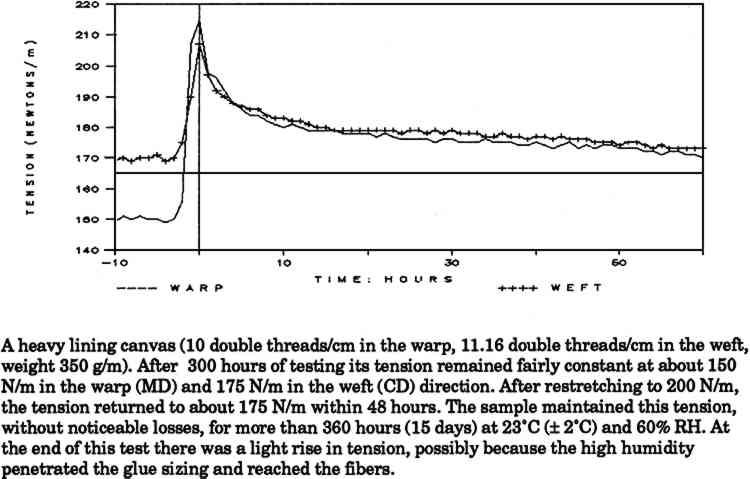DETERIORATION OF SURFACES EXPOSED TO ENVIRONMENTAL CHANGESGUSTAV A. BERGER, & WILLIAM H. RUSSELL
3 STRETCHING A CANVASWHILE STRETCHING a canvas, we intuitively reach a certain limit of tension, which is set by the fact that the canvas would tear at the tacks if stretched any further. This tension is usually around 200–300 N/m (l lb/in). When we check this canvas a few days later, we find that it has slackened and lost about one half of its tension (Hedley 1988). We can hasten the slackening of canvas by wetting, which would initially raise the tension to 700–900 N/m typically and overstretch the canvas in the process (fig. 1). Following drying, the tension drops to 40–60 N/m. No matter how often such cycles of stretching and wetting are repeated, the result will always be similar. Although there is usually a slight rise in the end-value at all points of the tension, caused by “case hardening” (i.e., polarization of the fibers) (Guilly, Sotton, and Chevalier 1981), the tension nevertheless reverts to almost the same level (fig. 3). We call this value maximum sustainable tension (MST). This value is valid, however, only for a specific environmental condition, as, for example, 21�C and 60% RH. From the 100th to the 180th hour of the test of the canvas described in figure 1, a steady MST of 200 N/m at 60% RH is recorded. When the canvas is stretched to 200 N/m, it has specific tensions for each level of temperature and RH. In
This brings out an important fact: The exposure to high RH and the resulting rise in tension to over 800 N/m have permanently deformed and enlarged the canvas. Unless the canvas is restretched (keyed out), it will no longer reach the tension of 100 N/m at 20% RH or of 200 N/m at 60% RH. This is the effect of only one short exposure to high RH (about three hours). Our tests have shown that longer and repetitive exposures to high RH lead to even more severe tension losses. Once stretched out, canvas can never be pushed together again by mechanical means. The environmental conditions to which the stretched canvas was exposed have caused irreversible mechanical and dimensional changes. These changes have resulted in a loss of tension which can only be corrected by outside intervention, such as keying out. Canvas stretched on a rigid stretcher may be considered a mechanism that, under the influence of environmental changes, enlarges the canvas and produces a loss of tension. It must be noted that as long as tension is maintained, the actual physical dimensions of the stretched canvas do not change. While we understand that the loss of tension is due The authors have repeated this experiment several times with the same results (Russell and Berger 1982), as did Guilly, Sotton, and Chevalier (1981). Depending on the canvas, it takes a size increase of about 0.3–0.4% to achieve the rise in tension necessary to regain the initial 205 N/m. However, for the “real” measurement of the change, this expansion is not enough, since with any sudden increase in tension there occurs slippage of the fibers and creep and the resulting rapid loss of tension. Repeated measurements have shown that a stretched canvas loses 30–50% of its tension in the first 48 hours following stretching (see above and fig. 3) (Russell and Berger 1982; Hedley 1988). To regain the initial tension of 205 N/m (the MST) after 48 hours, we would have to stretch the canvas by an additional 0.3–0.4% (a total of 0.6–0.8%) in order to raise the tension temporarily to above 300 N/m, which would allow it to drop to 205 N/m (after 48 hours). In a one-meter-long painting, 0.3–0.4% equal 3–4mm. Since keying out increases the size of the canvas in both directions, only one-half of this value is needed on each side (that is, square root of 3 to square root of 4, or 1.7–2.0 mm in each direction). Sizing, priming, and aging can change these values considerably. |
